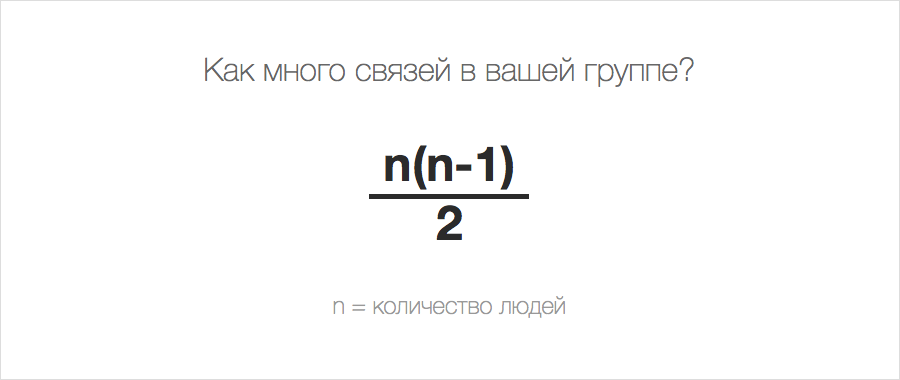Two pizzas: the perfect team size

Once, Amazon’s managers made a very reasonable suggestion that employees should communicate more often with each other. To everyone's surprise, the founder and CEO, Jeff Bezos, stood up and announced: “No, no more communication!”.
This position is explained by his famous rule - “team for two pizzas”. According to Bezos, the ideal team should not include more people than you can fill with two pizzas.
')
Increasing communication between employees does not necessarily solve communication problems — they just usually do it. Compare conversation at a dinner with a narrow circle of friends and at a party with a large number of guests. When there are a lot of people, it’s impossible to have a meaningful conversation with each guest, so people begin to gather in small groups.
Bezos believes that small teams are easier: to communicate more effectively (and not more), to remain decentralized, to develop more quickly and to encourage complete independence and innovation. Here’s the scientific rationale for why the two-pizza team rule really works.
Increasing team communication worsens
The problem of numerous teams is not so much their size. Psychologist and team development expert J. Richard Hackman notes that the real problem is the number of connections between people . Take a look at the formula:

As the group increases, connections between people become too much.
- If you take as a basis the size of a “team for two pizzas”, for example, consisting of 6 people, then the number of connections between them will be 15.
- We will increase the team to 12 people and get 66 connections.
- A small business of 50 people has as many as 1225 connections.
The cost of coordinating and communicating with each other grows so fast that it reduces the productivity of the team and each employee individually. Hackman explains: “The larger the group, the more difficulties its members encounter in the process of performing collective work. Even worse, as the group grows, its vulnerability to such difficulties increases dramatically. ”
"The team for two pizzas" protects against growth errors
Many managers and team leaders mistakenly believe that adding people to a team is always beneficial. People are the best assets, so adding assets should make progress, right?
The fact is that the large size of the team makes the staff arrogant . People tend to “more strongly underestimate the time to complete a task when a team grows,” explains researchers Bradley Staats, Catherine Milkman, and Craig Fox. In the course of one experiment, they found that a team of two people took 36 minutes to collect the same Lego design, and a team of four participants spent 52 minutes on this, which is 44% more. However, a team with a large number of participants was more confident in victory.
When launching a project is delayed, and you want to speed up this process, or at stake an important task, it seems sensible to connect additional employees. Following the rule of “two-pizza teams” will eliminate the tendency to underestimate the costs caused by additional connections.
Protection from stress and frustration
When psychologist Jennifer Muller was looking through the working journals of a research project, she noticed that people in numerous teams were more stressed . After talking with 200 employees working in teams ranging in size from three to nineteen people, she found that in large companies, people feel worse because of the so-called “loss of relationships”.
Loss of relationship is a feeling that you cannot get support: there is no one to lend a helping hand, solve a problem or listen carefully when it is necessary. Muller states:
“In numerous teams, people are confused. They do not know who to call for help, as they are not well acquainted with their colleagues. Even if one employee got through to another, he does not feel that the latter wants and has time to help. You also can’t tell a manager, because this will be a recognition of failure. ”
As connections grow in a growing team, team cohesion is lost, and it becomes increasingly difficult to get help. Careless addition of people to a team destroys the protective barrier of labor relations from stress.
In other words, big companies run the risk of destroying what I call the “goodwill” rule of productive teams. It is more difficult to be in an environment where everyone knows your name and understands what you are. This has a positive effect on day-to-day productivity and motivation.
***
Want to find your magic “team for two pizzas”? Here are 3 tips to help you with this.
1) What is the magic number?
The rule “teams for two pizzas” Bezos works for groups of up to 6-7 people. Collective work expert Hackman insists that the magic number is 5, and seriously warns not to go beyond 10. Management expert Bob Sutton, quoting American fur seals, says that the “optimal size of a combat team” is 4 people.
It's safe to say that a small team corresponds to a single number, so think about dividing your team into subgroups, if there are more than 10 people in it.
2) Follow the rule of "goodwill"
The loss of relationships occurs precisely at the level of perception, therefore, the stronger you unite the team, the better your team will be.
Zappos, which has several thousand employees, spends a lot of time developing corporate culture and creating a family atmosphere. They even came up with a “game of faces” - when an employee registers in the system, another person’s face appears on the screen with brief information, whose name needs to be guessed.
A small start-up Karma, following the rule of "goodwill", every day arranges family dinners together with the whole team.
3) Simplify teamwork with transparency
According to Hackman, one of the most important structures of effective teams is “an information system that provides participants with data and predicts their needs.”
The increase in connections between group members is bringing more misunderstanding and misinformation. Transparency through systems, processes and tools solves this problem: information is distributed evenly, colleagues are on the same wavelength and move forward together as a team.
Source: https://habr.com/ru/post/296620/
All Articles